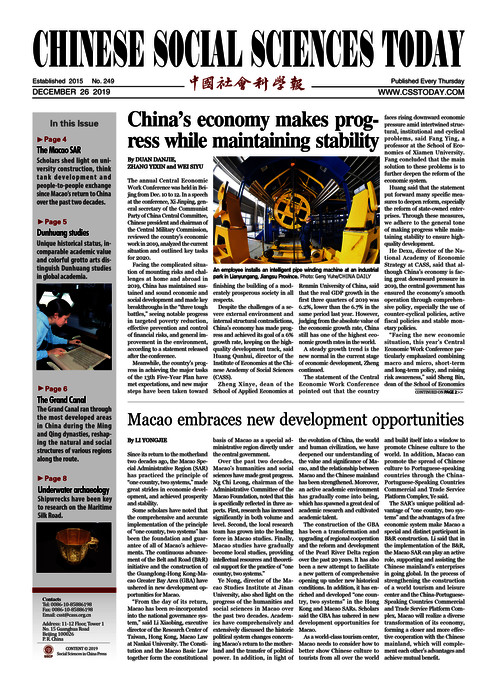China’s economy makes progress while maintaining stability
2019-12-26 09:36:30
An employee installs an intelligent pipe winding machine at an industrial park in Lianyungang, Jiangsu Province. Photo: Geng Yuhe/CHINA DAILY
By DUAN DANJIE,
ZHANG YIXIN and WEI SIYU
The annual Central Economic Work Conference was held in Beijing from Dec. 10 to 12. In a speech at the conference, Xi Jinping, general secretary of the Communist Party of China Central Committee, Chinese president and chairman of the Central Military Commission, reviewed the country’s economic work in 2019, analyzed the current situation and outlined key tasks for 2020.
Facing the complicated situation of mounting risks and challenges at home and abroad in 2019, China has maintained sustained and sound economic and social development and made key breakthroughs in the “three tough battles,” seeing notable progress in targeted poverty reduction, effective prevention and control of financial risks, and general improvement in the environment, according to a statement released after the conference.
Meanwhile, the country’s progress in achieving the major tasks of the 13th Five-Year Plan have met expectations, and new major steps have been taken toward finishing the building of a moderately prosperous society in all respects.
Despite the challenges of a severe external environment and internal structural contradictions, China’s economy has made progress and achieved its goal of a 6% growth rate, keeping on the high-quality development track, said Huang Qunhui, director of the Institute of Economics at the Chinese Academy of Social Sciences (CASS).
Zheng Xinye, dean of the School of Applied Economics at Renmin University of China, said that the real GDP growth in the first three quarters of 2019 was 6.2%, lower than the 6.7% in the same period last year. However, judging from the absolute value of the economic growth rate, China still has one of the highest economic growth rates in the world.
A steady growth trend is the new normal in the current stage of economic development, Zheng continued.
The statement of the Central Economic Work Conference pointed out that the country faces rising downward economic pressure amid intertwined structural, institutional and cyclical problems, said Fang Ying, a professor at the School of Economics of Xiamen University. Fang concluded that the main solution to these problems is to further deepen the reform of the economic system.
Huang said that the statement put forward many specific measures to deepen reform, especially the reform of state-owned enterprises. Through these measures, we adhere to the general tone of making progress while maintaining stability to ensure high-quality development.
He Dexu, director of the National Academy of Economic Strategy at CASS, said that although China’s economy is facing great downward pressure in 2019, the central government has ensured the economy’s smooth operation through comprehensive policy, especially the use of counter-cyclical policies, active fiscal policies and stable monetary policies.
“Facing the new economic situation, this year’s Central Economic Work Conference particularly emphasized combining macro and micro, short-term and long-term policy, and raising risk awareness,” said Sheng Bin, dean of the School of Economics at Nankai University. The conference proposed ways to optimize economic governance, truly solve the problems facing small- and medium-sized enterprises, and alleviate their difficulties in accessing affordable financing.
In particular, Sheng said, we must focus on defusing the risks of the financial system and strive to solve the problems of debt and inflation and the external risks of economic downturn at the industry and regional levels.
High-quality development is an integrated system that pursues the coordinated development of economy, society and ecology, Zheng said. When assessing the quality of economic development, we cannot simply adopt a single economic indicator, but should systematically analyze a system of indicators that serves high-quality development.
The key to continuing to implement a proactive fiscal policy and a prudent monetary policy lies in accurately understanding the causes of the current economic downturn, Fang said. It is necessary to clearly distinguish between cyclical factors and structural factors and to soundly control the intensity and direction of counter-cyclical adjustments in macro-policy. Attention should also be paid to the better coordination of fiscal and monetary policies.
While maintaining reasonable and sufficient liquidity and ensuring that the scale of monetary credit and social financing can meet the needs of economic development, we need to further utilize structural monetary policy tools to more accurately serve specific industries and private and small- and medium-sized enterprises, Fang said.
Sheng said that China’s economy is shifting its growth equation away from investment and exports and toward consumption demand. It is necessary to push consumption, stimulate economic growth and ensure people’s well-being. China’s opening to the outside world must shift from market opening to institutional opening, establishing a modern economic system in such areas as the business environment, regulatory innovation, regulatory reform, investment liberalization and facilitation in service trade, in line with the evolving new rules for international trade and investment.



